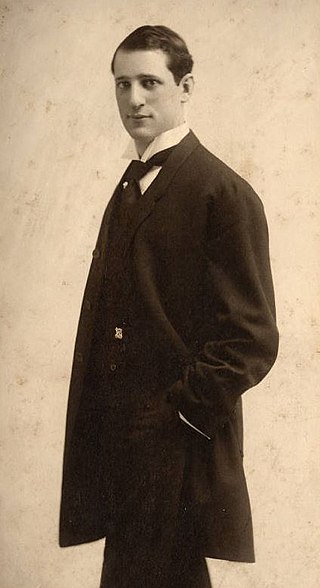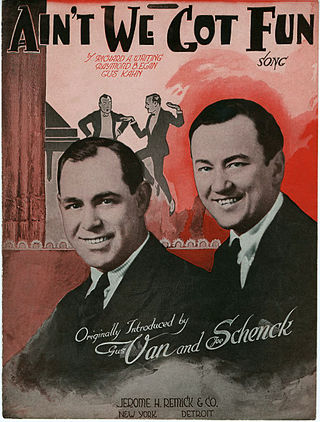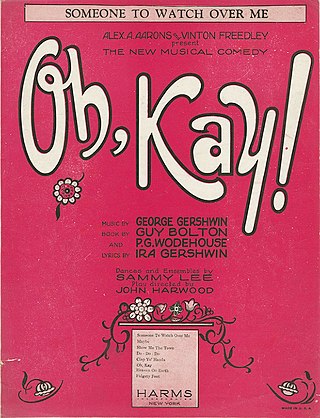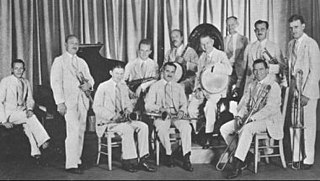Related Research Articles

Andy Razaf was an American poet, composer, and lyricist of such well-known songs as "Ain't Misbehavin'" and "Honeysuckle Rose".

Albert Von Tilzer was an American songwriter, the younger brother of fellow songwriter Harry Von Tilzer. He wrote the music to many hit songs, including, most notably, "Take Me Out to the Ball Game".

Tin Pan Alley was a collection of music publishers and songwriters in New York City that dominated the popular music of the United States in the late 19th and early 20th centuries. Originally, it referred to a specific location on West 28th Street, between Fifth and Sixth Avenues in the Flower District of Manhattan, as commemorated by a plaque on 28th Street between Broadway and Sixth. Several buildings on Tin Pan Alley are protected as New York City designated landmarks, and the section of 28th Street from Fifth to Sixth Avenue is also officially co-named Tin Pan Alley.

A refrain is the line or lines that are repeated in music or in poetry—the "chorus" of a song. Poetic fixed forms that feature refrains include the villanelle, the virelay, and the sestina.
Children's music or kids' music is music composed and performed for children. In European-influenced contexts this means music, usually songs, written specifically for a juvenile audience. The composers are usually adults. Children's music has historically held both entertainment and educational functions. Children's music is often designed to provide an entertaining means of teaching children about their culture, other cultures, good behavior, facts and skills. Many are folk songs, but there is a whole genre of educational music that has become increasingly popular.
The Great American Songbook is the loosely defined canon of significant 20th-century American jazz standards, popular songs, and show tunes.
Tin Pan Alley Cats is a 1943 Warner Bros. Merrie Melodies directed by Bob Clampett. A follow-up to Clampett's successful Coal Black and de Sebben Dwarfs, released earlier in 1943, Tin Pan Alley Cats focuses upon contemporary themes of African-American culture, jazz music, and World War II, and features a caricature of jazz musician Fats Waller as an anthropomorphic cat. The short's centerpiece is a fantasy sequence derived from Clampett's black and white Looney Tunes short Porky in Wackyland (1938).

Mort Dixon was an American lyricist.

"Ain't We Got Fun" is a popular foxtrot published in 1921 with music by Richard A. Whiting, lyrics by Raymond B. Egan and Gus Kahn.

"Someone to Watch Over Me" is a 1926 song composed by George Gershwin with lyrics by Ira Gershwin, assisted by Howard Dietz who penned the title. It was written for the musical Oh, Kay! (1926), with the part originally sung on Broadway by English actress Gertrude Lawrence while holding a rag doll in a sentimental solo scene. The musical ran for more than 200 performances in New York and then saw equivalent acclaim in London in 1927, all with the song as its centerpiece. Lawrence released the song as a medium-tempo single which rose to number 2 on the charts in 1927.

"The Sheik of Araby" is a song that was written in 1921 by Harry B. Smith and Francis Wheeler, with music by Ted Snyder. It was composed in response to the popularity of the Rudolph Valentino feature film The Sheik.
Harry MacGregor Woods was a Tin Pan Alley songwriter and pianist. He was a composer of numerous film scores.
Philip George Furia was an American author and English literature professor. His books focus on the lyricists of the Tin Pan Alley era.

Herbert Arthur Wiedoeft was a German-American band leader in California in the 1920s.

The period from the end of the First World War until the start of the Depression in 1929 is known as the "Jazz Age". Jazz had become popular music in America, although older generations considered the music immoral and threatening to cultural values. Dances such as the Charleston and the Black Bottom were very popular during the period, and jazz bands typically consisted of seven to twelve musicians. Important orchestras in New York were led by Fletcher Henderson, Paul Whiteman and Duke Ellington. Many New Orleans jazzmen had moved to Chicago during the late 1910s in search of employment; among others, the New Orleans Rhythm Kings, King Oliver's Creole Jazz Band and Jelly Roll Morton recorded in the city. However, Chicago's importance as a center of jazz music started to diminish toward the end of the 1920s in favor of New York.

Houp La! is an Edwardian musical comedy extravaganza, with music by Nat D. Ayer and Howard Talbot, lyrics by Percy Greenbank and Hugh E. Wright, and a book by Fred Thompson and Hugh E. Wright. The story combines the comic financial troubles of a circus owner with a love triangle.

Pop Pop is an album by the American musician Rickie Lee Jones, released in September 1991.
"You're My Everything"' is a 1931 song with music by Harry Warren and lyrics by Mort Dixon and Joe Young. The song was written for the revue The Laugh Parade starring Ed Wynn which opened in New York City on November 2, 1931. The song was sung by Jeanne Aubert and Lawrence Gray.

September in the Rain is a 1937 Warner Bros. Merrie Melodies cartoon directed by Friz Freleng. The short was released on December 18, 1937.
References
- ↑ "On the isle of Wicki Wacki Woo : fox trot" at OCLC WorldCat retrieved 8/6/15
- ↑ "Adolph Robinson in Major Bowes' Harmony Broadcast - 1935" on YouTube Historical background.
- ↑ "Willie "The Lion" Smith - The Lion on BBC's "Jazz 625" - 1965" on YouTube Historical background
- ↑ "Willie The Lion Smith - Nagasaki (Live)" on YouTube
- ↑ "That Old Feeling: We Need Harry Warren", Time, Oct. 5, 2001.
- ↑ "Misce-Looney-Ous: Reused Animation: The 1940s" Archived 2005-04-05 at the Wayback Machine Re-use of "Nagasaki" in Tin Pan Alley Cats.
- ↑ Rickie Lee Jones official site, Kicks page